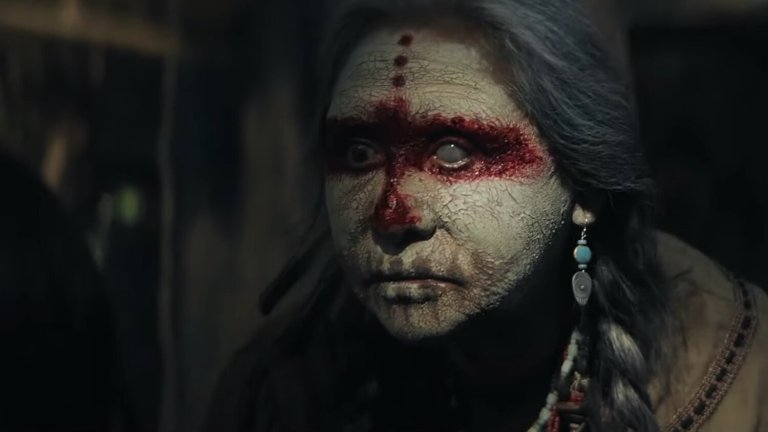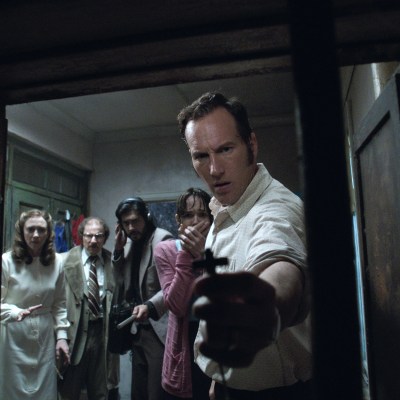The Old Ways: La Boca, Postehki, Brujas, and the Real Cueva del Diablo in Mexico
Brigitte Kali Canales and Andrea Cortes star in The Old Ways, a tale of witchcraft set in Mexico.

By the end of The Old Ways, we’ve learned a few things about Brigitte Kali Canales’ Cristina, primarily that she’s been lost for much longer than the movie lets on. Sure, she finds herself captive in a village in the outskirts of Veracruz, Mexico, but she wasn’t any closer to home as a reporter in Los Angeles. In fact, Cristina admits in one of the best scenes of the movie that she’s always felt displaced anywhere she went, that she doesn’t think there’s a home for her, which is why she’s run away from her life in order to find death.
But by the time the credits roll on this tale of witchcraft, Cristina has instead found purpose as the new bruja (Spanish for “witch”) of the Mexican village where she was born, ready to continue fighting the demons that lurk in La Boca as her unlikely mentor Luz once did.
“We’re not good at this, but we’re going to get better,” Cristina tells Carson in the final scene of the movie. Her former editor has come looking for her but has accidentally stumbled into La Boca himself. He too will soon learn of the old ways.
While there isn’t an actual La Boca cave in Veracruz — at least not by that name — some elements of The Old Ways‘ story are still steeped in real Mexican folklore and witchcraft.
La Boca and Postehki
While we initially believe that Cristina is in Mexico to report on the local beliefs and shamanic practices of the brujos living in her hometown of Catemaco, a place she hasn’t visited since the death of her mother during an exorcism, Cristina admits to her cousin Miranda (Andrea Cortes) that La Boca was her destination all along. Despite being warned not to step foot in the cave that’s said to harbor demonic spirits, Cristina plans to kill herself there.
In the movie, La Boca is the lair of Postehki, the “death god of broken things” who feeds on the souls of those who enter the cave. Postehki draws victims who are depressed or in pain, which is why it preys on Cristina, who is also suffering from a heroin addiction, making her more susceptible to the visions and influence of the demon.
Postehki isn’t a real deity from Aztec mythology, though. In the Nahuatl language spoken by Luz and the other indigenous people descended from the Aztecs, “postehki” means “broken” or “to break,” which could be how director Christopher Alender and writer Marcos Gabriel came up with the name for the demon. That said, Postehki could be inspired by real Aztec deities, like Mictlantecuhtli, the Aztec god of the dead, who is depicted as a tall, bloody skeleton with sharp teeth and a necklace made of human eyeballs, although the description isn’t a perfect match with what we see on screen.
After several attempts at making Postehki reveal itself, Cristina discovers the “broken man” ritual in one of Luz’s books, which the bruja agrees to perform. The ritual itself involves nailing a triangular artifact to the ground, which in turn traps the possessed long enough for the bruja to rip out the demon. Seeing it in action, it looks a lot like a crucifixion, with red dots on Cristina’s palms made to look like the Christian stigmata.
Again, it doesn’t appear the “broken man” is based on a real ritual, although the picture drawn in Luz’s read book does look a bit like “The Hanged Man” from the Tarot, which can be interpreted as a symbol of self-sacrifice. In this case, it could be a reference to the way Luz sacrifices herself in order to save Cristina, or the way Cristina must give herself to the old ways in order finally find peace. Whether Luz knowingly saves her soon-to-be successor in order to preserve “the old ways” is unclear.
Brujas, Catemaco, and Cueva del Diablo
What is clear is that Alender and Gabriel borrowed from a mix of cultural influences for their tale of brujas and demons. Gabriel told Fangirlish that stories told to him by his mother and grandmother in his native Puerto Rico were inspirations for the story.
“As we developed the story further, we kind of settled on this region of Mexico, Veracruz. It was kind of the place where we felt that we could pull a lot of influences for,” Gabriel said of the movie’s setting. “So, as you know since you’re from Puerto Rico, we have the Afro Caribbean influences that kind of came in. And it’s kind of right along the Caribbean there, Veracruz. So, that draws in some of the influences. Catholicism and you also have the Aztec and Mayan influences of the region. And just that area, Catemaco, is kind of known as the witchcraft capital of Mexico.”
Indeed, Catemaco, which is located in the southern part of the state of Veracruz, has a long tradition with brujos dating back to the Olmecs, the earliest known Mesoamerican civilization to settle in the region. Today, it’s common for tourists to visit Catemaco’s curanderos (healers like Luz) for a limpia (ritual cleansing). But there are also those in Catemaco known to practice black magic and are said to worship the Devil. Just a few minutes northwest of Catemaco is a place called la Cueva del Diablo (Devil’s Cave), where black masses are performed by the “brujo mayor” (the high witch or sorcerer) who is said to sacrifice animals in the name of the Devil or Santa Muerte (the Mexican folk saint of death). A black mass kicks off the annual national congress of brujos of Catemaco, which is held on the first Friday of March.
Catemaco and its Devil’s Cave sound like the perfect location for this story, but Alender actually found La Boca in the Camuy cave system in northwestern Puerto Rico.
“We got into the Camuy caves and they were just unbelievable. Long before, a year or two before we started the movie, we had drawn on a marker eraser board on what La Boca should look like and I wanted it to look like a big toothy and evil mouth. And we found…I can literally superimpose the dry eraser drawing right over the cave we found. It was exactly the cave. And it was so cool to go in there and have this all come to life. It was completely full of bats. We couldn’t hear each other talk in there. It was so loud with the water rushing through and the bats making noises and stuff.”
Sounds like Alender and Gabriel had a better time in La Boca than Cristina did.
The Old Ways is streaming now on Netflix.

